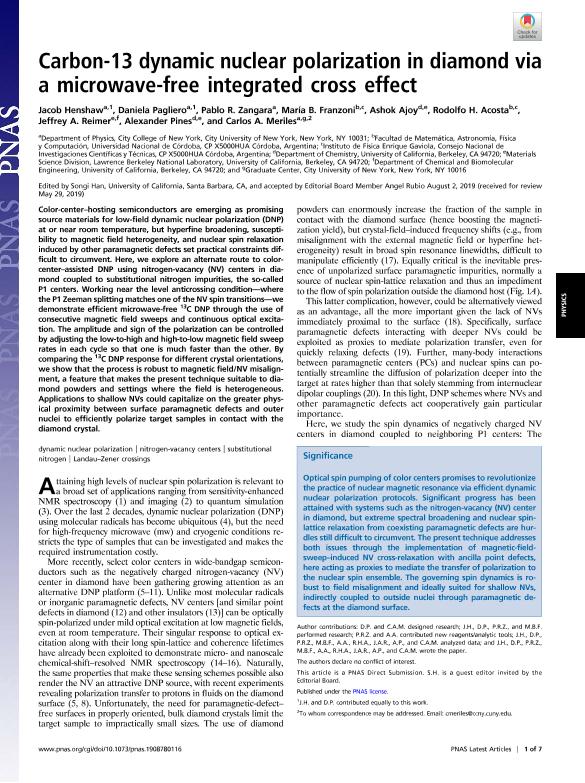Mostrar el registro sencillo del ítem
dc.contributor.author
Henshaw, Jacob
dc.contributor.author
Pagliero, Daniel
dc.contributor.author
Zangara, Pablo René

dc.contributor.author
Franzoni, Maria Belen

dc.contributor.author
Ajoy, Ashok
dc.contributor.author
Acosta, Rodolfo Héctor

dc.contributor.author
Reimer, Jeffrey A.
dc.contributor.author
Pines, Alexander
dc.contributor.author
Meriles, Carlos A.
dc.date.available
2021-02-15T21:13:45Z
dc.date.issued
2019-09
dc.identifier.citation
Henshaw, Jacob; Pagliero, Daniel; Zangara, Pablo René; Franzoni, Maria Belen; Ajoy, Ashok; et al.; Carbon-13 dynamic nuclear polarization in diamond via a microwave-free integrated cross effect; National Academy of Sciences; Proceedings of the National Academy of Sciences of The United States of America; 116; 37; 9-2019; 18334-18340
dc.identifier.issn
0027-8424
dc.identifier.uri
http://hdl.handle.net/11336/125699
dc.description.abstract
Color-center–hosting semiconductors are emerging as promising source materials for low-field dynamic nuclear polarization (DNP) at or near room temperature, but hyperfine broadening, susceptibility to magnetic field heterogeneity, and nuclear spin relaxation induced by other paramagnetic defects set practical constraints difficult to circumvent. Here, we explore an alternate route to color-center–assisted DNP using nitrogen-vacancy (NV) centers in diamond coupled to substitutional nitrogen impurities, the so-called P1 centers. Working near the level anticrossing condition—where the P1 Zeeman splitting matches one of the NV spin transitions—we demonstrate efficient microwave-free 13C DNP through the use of consecutive magnetic field sweeps and continuous optical excitation. The amplitude and sign of the polarization can be controlled by adjusting the low-to-high and high-to-low magnetic field sweep rates in each cycle so that one is much faster than the other. By comparing the 13C DNP response for different crystal orientations, we show that the process is robust to magnetic field/NV misalignment, a feature that makes the present technique suitable to diamond powders and settings where the field is heterogeneous. Applications to shallow NVs could capitalize on the greater physical proximity between surface paramagnetic defects and outer nuclei to efficiently polarize target samples in contact with the diamond crystal.
dc.format
application/pdf
dc.language.iso
eng
dc.publisher
National Academy of Sciences

dc.rights
info:eu-repo/semantics/openAccess
dc.rights.uri
https://creativecommons.org/licenses/by-nc-sa/2.5/ar/
dc.subject
DYNAMIC NUCLEAR POLARIZATION
dc.subject
LANDAU–ZENER CROSSINGS
dc.subject
NITROGEN-VACANCY CENTERS
dc.subject
SUBSTITUTIONAL NITROGEN
dc.subject.classification
Física Atómica, Molecular y Química

dc.subject.classification
Ciencias Físicas

dc.subject.classification
CIENCIAS NATURALES Y EXACTAS

dc.subject.classification
Óptica

dc.subject.classification
Ciencias Físicas

dc.subject.classification
CIENCIAS NATURALES Y EXACTAS

dc.title
Carbon-13 dynamic nuclear polarization in diamond via a microwave-free integrated cross effect
dc.type
info:eu-repo/semantics/article
dc.type
info:ar-repo/semantics/artículo
dc.type
info:eu-repo/semantics/publishedVersion
dc.date.updated
2020-11-19T21:25:49Z
dc.identifier.eissn
1091-6490
dc.journal.volume
116
dc.journal.number
37
dc.journal.pagination
18334-18340
dc.journal.pais
Estados Unidos

dc.journal.ciudad
Washington DC
dc.description.fil
Fil: Henshaw, Jacob. City University of New York; Estados Unidos
dc.description.fil
Fil: Pagliero, Daniel. City University of New York; Estados Unidos
dc.description.fil
Fil: Zangara, Pablo René. City University of New York; Estados Unidos. Consejo Nacional de Investigaciones Científicas y Técnicas. Centro Científico Tecnológico Conicet - Córdoba. Instituto de Física Enrique Gaviola. Universidad Nacional de Córdoba. Instituto de Física Enrique Gaviola; Argentina
dc.description.fil
Fil: Franzoni, Maria Belen. Universidad Nacional de Córdoba. Facultad de Matemática, Astronomía y Física; Argentina. Consejo Nacional de Investigaciones Científicas y Técnicas. Centro Científico Tecnológico Conicet - Córdoba. Instituto de Física Enrique Gaviola. Universidad Nacional de Córdoba. Instituto de Física Enrique Gaviola; Argentina
dc.description.fil
Fil: Ajoy, Ashok. Lawrence Berkeley National Laboratory; Estados Unidos. University of California at Berkeley; Estados Unidos
dc.description.fil
Fil: Acosta, Rodolfo Héctor. Universidad Nacional de Córdoba. Facultad de Matemática, Astronomía y Física; Argentina. Consejo Nacional de Investigaciones Científicas y Técnicas. Centro Científico Tecnológico Conicet - Córdoba. Instituto de Física Enrique Gaviola. Universidad Nacional de Córdoba. Instituto de Física Enrique Gaviola; Argentina
dc.description.fil
Fil: Reimer, Jeffrey A.. University of California at Berkeley; Estados Unidos
dc.description.fil
Fil: Pines, Alexander. Lawrence Berkeley National Laboratory; Estados Unidos. University of California at Berkeley; Estados Unidos
dc.description.fil
Fil: Meriles, Carlos A.. City University of New York; Estados Unidos
dc.journal.title
Proceedings of the National Academy of Sciences of The United States of America

dc.relation.alternativeid
info:eu-repo/semantics/altIdentifier/url/http://www.pnas.org/lookup/doi/10.1073/pnas.1908780116
dc.relation.alternativeid
info:eu-repo/semantics/altIdentifier/doi/http://dx.doi.org/10.1073/pnas.1908780116
dc.relation.alternativeid
info:eu-repo/semantics/altIdentifier/url/https://pubmed.ncbi.nlm.nih.gov/31451667/
Archivos asociados
